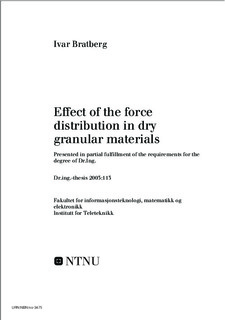| dc.contributor.author | Bratberg, Ivar | nb_NO |
| dc.date.accessioned | 2014-12-19T13:29:37Z | |
| dc.date.available | 2014-12-19T13:29:37Z | |
| dc.date.created | 2004-01-23 | nb_NO |
| dc.date.issued | 2004 | nb_NO |
| dc.identifier | 124936 | nb_NO |
| dc.identifier.isbn | 82-471-5669-5 | nb_NO |
| dc.identifier.uri | http://hdl.handle.net/11250/249768 | |
| dc.description.abstract | This work concentrates on the force-network of dry granular materials. The dynamical and static properties of the force-network are studied through simulations and experiments.
We study the structural properties of two-dimensional granular packings prepared by random deposition from a source line. We consider a class of random ballistic deposition models based on single-particle relaxation rules controlled by a critical angle, and show that these local rules can be formulated as rolling friction in the framework of dynamic methods for the simulation of granular materials. We find that the packing prepared by random deposition models is generically unstable, and undergoes dynamic rearrangements. As a result, the dynamic method leads systematically to a higher solid fraction than the geometrical model for the same critical angle. We characterise the structure of the packings generated by both methods in terms of solid fraction, contact connectivity and anisotropy. Our analysis provides evidence for four packing regimes as a function of solid fraction, the mechanisms of packing growth being different in each regime.
Using the Contact Dynamics method, the stick-slip response of an pushed granular column is analysed and a power law is found for the distribution of slips with exponent value 1:8. The exponent is invariable to perturbations of the different physical parameters. Two velocity regimes were found: stick-slip and steady state. These two regimes could be observed for very simple systems, making a detailed analyses possible.
An experiments on narrow granular columns to test the validity of the Janssen law under such conditions has been done. The weight at the bottom of the cylinder and the compression and movement of the packing have been measured. The apparent mass dependence on height is not in good agreement with the Janssen law using a oneparameter fit. A two-parameter fit yilded good results for the apparent mass during upwards and downwards movement at constant velocity of the granular column inside the enclosing cylinder. The necessity of two parameters has its origin in rotational frustration. The dependence of the apparent mass on the diameter of the column does not follow the Janssen law. Rather, it depends strongly on details of the packing. | nb_NO |
| dc.language | eng | nb_NO |
| dc.publisher | Fakultet for informasjonsteknologi, matematikk og elektroteknikk | nb_NO |
| dc.relation.ispartofseries | Dr. ingeniøravhandling, 0809-103X; 2003:113 | nb_NO |
| dc.title | Effects of the Force Distribution in Dry Granular Materials | nb_NO |
| dc.type | Doctoral thesis | nb_NO |
| dc.contributor.department | Norges teknisk-naturvitenskapelige universitet, Fakultet for informasjonsteknologi, matematikk og elektroteknikk | nb_NO |
| dc.description.degree | dr.ing. | nb_NO |
| dc.description.degree | dr.ing. | en_GB |
